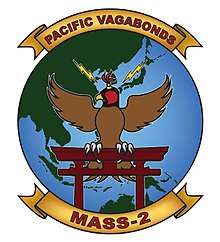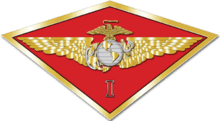Marine Air Support Squadron 2
| Marine Air Support Squadron 2 | |
|---|---|
 | |
| Active | January 1, 1943 - present |
| Country | United States |
| Branch | USMC |
| Type | Aviation command and control |
| Role | Provide the DASC |
| Part of |
Marine Air Control Group 18 1st Marine Aircraft Wing |
| Garrison/HQ | Marine Corps Air Station Futenma |
| Nickname(s) | "Pacific Vagabonds" |
| Anniversaries | January 1, 2018 - 75th Anniversary |
| Engagements |
World War II Korean War Vietnam War Operation Desert Storm Operation Enduring Freedom |
| Commanders | |
| Current commander | LtCol Mark E. Murphy |
Marine Air Support Squadron 2 (MASS-2), is a United States Marine Corps aviation command and control unit that provides the Direct Air Support Center (DASC) for the III Marine Expeditionary Force. They are based out of Marine Corps Air Station Futenma, Okinawa, Japan.
Mission
Provide Direct Air Support Center (DASC) capabilities for control and coordination of aircraft operating in direct support of Marine Air-Ground Task Force (MAGTF) Forces.
History
World War II
Marine Air Support Squadron 2 was activated 1 January 1943, at Marine Corps Air Station El Centro, California, as Headquarters Squadron 43, Services Group, Marine Wings Pacific. The unit originally functioned as the headquarters element of Marine Aircraft Base Defense Group 43. In November 1944, the Group was assigned to Marine Aircraft Group 43. During the first two years of its existence the Squadron remained in California. With the departure of the Group, however, Headquarters Squadron 43 also moved to Hawaii. While deployed to the territory of Hawaii in January 1945, Headquarters Squadron 43 and Marine Aircraft Group 43 were reassigned to the 2nd Marine Aircraft Wing.
The stay in Hawaii was only of a brief duration, because on 22 February 1945, Headquarters Squadron 43 embarked and sailed on board the USS Allendale for the Western Pacific. Marine Aircraft Group 43 was designate to be in charge of the air defense fight in the forthcoming Battle of Okinawa. Its mission was first to occupy Japanese airfields and then to aid in furnishing of aerial defense for ground troops. Upon landing, the Squadron assumed the responsibility of assisting in the development and operation of air warning and fighter direction facilities within the Air Defense Command. During the course of the battle the unit was located about 1 km southeast of Yontan Airfield and was subjected to nearly nightly Japanese Air Raids. Five enlisted Marines from the unit were killed on April 20, 1945 when a Japanese plane dropped a bomb on the mess tent. For its service during the battle for the island, the Squadron was awarded the Presidential Unit Citation.
On 1 August 1945, Headquarters Squadron 43 was re-designated as Headquarters Squadron, Marine Air Defense Command 2 (MADC-2). The squadron transferred responsibility for the Okinawa area to the 301st Fighter Wing on 1 January 1946 and began preparations to return to the United States. Headquarters Squadron was reassigned in February 1946 to the 4th Marine Aircraft Wing and was reassigned to Air Fleet Marine Force, Pacific. They closed their Okinawa Command Post at 1300 on 29 March 1946 and proceeded to board the USS Waukesha (AKA-84) for transit home. THe squadron arrived back in San Diego on 15 April 1946 and were immediately redesignated as Headquarters Squadron, Marine Air Warning Group 2. On 1 August 1946, the unit was again redesignated as Headquarters Squadron, Marine Air Control Group 2 and relocated to Marine Corps Air Station Santa Ana, California. On 1 July 1947 the squadron was given the name Marine Tactical Air Control Squadron 2 (MTACS-2). There newly assigned mission was to provide the central control facilities for air defense and air support operations, furnish administrative support to Group Headquarters and operate the special air control equipment assigned.
Korean War
Marine Tactical Air Control Squadron 2 participated in action during the Korean War at the Battle of Pusan Perimeter, Battle of Inchon, Battle of Chosin Reservoir, the East Central Front, and the Western Front.
Upon arrival at Kobe, Japan on August 1, 1950 the air support section of the squadron sailed for Pusan to control close air support missions for the 1st Provisional Marine Brigade. Three days later, on 4 August, the Air Support Section entered Korea, and assumed control of all close air support aircraft for the 1st Provisional Marine Brigade engaged on the Pusan perimeter. The air defense section remained in Japan; it set up operations at Itami Air Force Base, Honshu, Japan to be co-located with VMF(N)-513.[1] For the Inchon invasion, both sections of MTACS-2 departed their respective locations and headed for the new front. On 17 September, the squadron disembarked at Inchon. The air support section aided the 1st Marine Division by enabling close air support throughout the battle. The air defense section provided air defense surveillance against possible enemy air intrusion. When the 1st Marine Division sailed for Wonsan, both the Air Support and defense sections of MTACS-2 sailed with them. Upon arrival at Wonsan, the Air Support section debarked on October 26, 1950, establishing the TADC on Wonsan Airfield, The Air Defense section moved to nearby Hamhung and was joined by the TADC on 6 November 1950. The Air Support section was with the 1st Marine Division from November 27 - December 10, 1950 during the Battle of Chosin Reservoir. They controlled the flow of aircraft in support of the division and also manned a portion of the western perimeter at Hagaru-ri where the Division Headquarters was located.[2]
After the successful breakout of the Chosin Reservoir, the Air Support section was transported to Masan, on the southern coast of Korea. The Air Defense section remained aboard ship and sailed for Pusan, Korea and set up the TACC for operation at Pusan West AB (K-1). In August 1951, the Marine Air Support Radar Team 1 arrived from CONUS and was attached to MTACS-2. In March 1952, the Air Support section moved with the 1st Marine Division to the western front near Panmunjum. The Air Defense section continued to operate the TACC of the 1st Marine Aircraft Wing from its location at K-3 Airfield. The Squadron remained in Korea for the rest of the war until the Truce was signed in July 1953.
Interwar years
During the period July 1953 to July 1956, the squadron participated in the defense of the Korean Demilitarized Zone. They were stationed in the vicinity of Pohang, Korea and continued to train and participate in exercises. On 15 February 1954, Marine Tactical Air Control Squadron 2 was re-designated as Marine Air Support Squadron 2 (MASS-2). In July 1956, MASS-2 departed Korea for Marine Corps Air Station Iwakuni, Japan. The squadron remained at Iwakuni for the next 6 years continuing to train and support exercises across the Pacific. In March 1961, the squadron again moved to Okinawa, Japan. They were originally stationed at Camp Hague until September 1962 when they moved to MCAS Futenma.
Vietnam War
MASS-2 operated in the Republic of Vietnam from 1965 to 1969. Early in April 1965 the Squadron was alerted for deployment to Vietnam. While in Vietnam, MASS-2 conducted operations at Da Nang, Chu Lai, Quảng Ngai, Marble Mountain, Phu Bai, Đông Hà, Camp Carroll, and Signal Hill, as well as other locations. The squadron redeployed to Iwakuni, Japan, in 1969 and, in 1973, became home-based at MCAS Futenma, Okinawa. During the Vietnam War, MASS-2 operated as an agency of the Marine Air Command and Control System of the 1st Marine Aircraft Wing while supporting the 3d Marine Division by providing DASC and ASRT combat support.
1965
MASS-2 departed Naha, Okinawa on 11 April 1965 on board the USS Washtenaw County. They arrived at Da Nang on 16 April 1965 and set up the DASC (callsign Landshark) 250 yards west of the runway at Da Nang Air Base. The squadron also set up an AN/TPQ-10 Air Support Radar Team. The DASC took control of their assigned airspace at 08:30 on 22 April. The first ASRT mission took place on 30 April when they controlled a flare dispensing mission in the vicinity of Da Nang. On 18 August, a second DASC (callsign Landshark Alpha) became operational at Chu Lai Air Base. Beginning on 1 May through the end of the year, MASS-2's two DASCs controlled 9562 missions and helped coordinate 994 medevacs throughout their assigned area of responsibility. While the original ASRT remained in Da Nang, the squadron added three more which also operated from Pleiku Air Base and later Chu Lai. The squadron's multiple Air Support Radar Teams would control 1872 missions throughout the year, resulting in the expending of approximately 4,886,000 lbs of ordnance in support of Marine operations. During this time MASS-2 also provided mobile DASCs and a DASC Airborne capability in support of numerous named operations. Named operations that the squadron supported in 1965 include Starlite, Piranha, Red Snapper, Black Ferret, Blue Marlin & Harvest Moon.
1969
In January 1969, MASS-2 assumed control of the Vandegrift DASC which was located on Route 9 just south of the Rockpile. The Da Nang ASRT was airlifted to Fire Support Base Cunningham in order to support Operation Dewey Canyon. On 18 April, after more than 4 years at Da Nang, the MASS-2 Command Post moved to Đông Hà. In May, an ASRT was sent to Fire Support Base Birmingham to support the 101st Airborne Division during Operation Apache Snow in the A Sầu Valley. The Vandegrift DASC was re-designated as a Helicopter Direction Center (HDC) in July 1969 after 9th Marines departed Vietnam. In the fall of 1969, MASS-2 received orders to redeploy from Vietnam. On 4 November 1969, MASS-2's last tactical agency in country went off the air when the Dong Ha DASC closed. On 4 November a 40 man detachment sailed from Cua Viet onboard the USS Meeker County (LST-980) enroute to MCAS Futenma, Japan. On 22 November, the remainder of the squadron embarked on the USS Windham County (LST-1170) enroute to Marine Corps Air Station Iwakuni thus closing the chapter on MASS-2's 4 1/2 year involvement in the Vietnam War.
Global War on Terror
Personnel from MASS-2 have augmented other units deploying to Afghanistan in support of Operation Enduring Freedom. They have also provided Marines for the 31st Marine Expeditionary Unit which has deployed to Iraq in support of Operation Iraqi Freedom.
See also
Notes
- ↑ Field Jr., James A. (June 21, 2000). "Chapter 5: Into the Perimeter, Part 6. The Marines Arrive". History of United States Naval Operations: Korea. Department of the Navy - Naval Historical Center. Retrieved 2007-12-19.
- ↑ Hammel Chosin, p.154.
References
- Bibliography
- Hammel, Eric (1981). Chosin - Heroic Ordeal of the Korean War. Presidio Press. ISBN 0-89141-378-2.
- Web
External links

